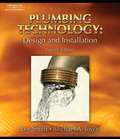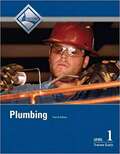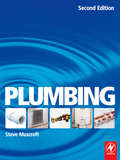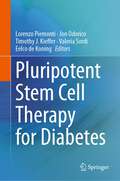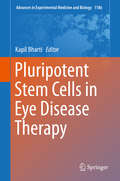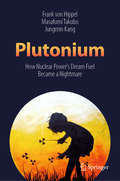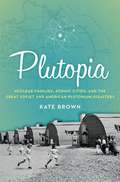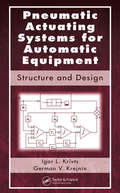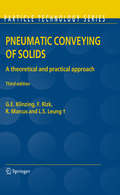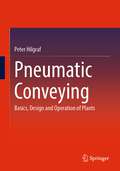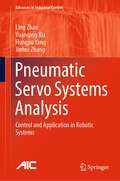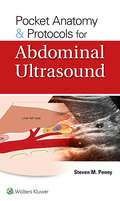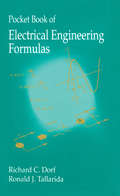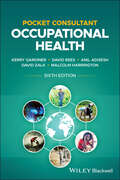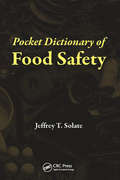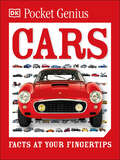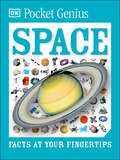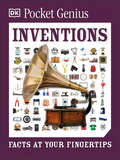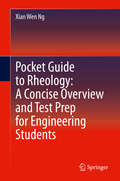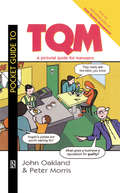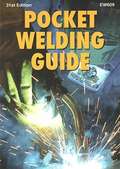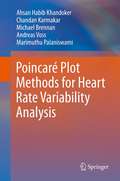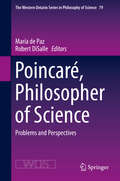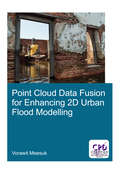- Table View
- List View
Plumbing Technology: Design and Installation
by Lee Smith Michael A. JoyceIntroduces readers to all aspects of the commercial and residential plumbing trade, including home building. Safety practices are emphasized throughout. Projects provide opportunities for hands-on plumbing practice and actual application. Coverage includes basic knowledge, threaded pipe, waste systems, water systems, heating water, special cases, and fixture installation. This third edition covers current plumbing codes, and adds new pedagogical features. Useful for plumbers preparing to pass the Master Plumber exam. Annotation c. Book News, Inc. , Portland, OR (booknews. com)
Plumbing, Level 1
by NccerThis exceptionally produced trainee guide features a highly illustrated design, technical hints and tips from industry experts, review questions and a whole lot more! Key content includes: Introduction to the Plumbing Profession, Plumbing Safety, Tools of the Plumbing Trade, Introduction to Plumbing Math, Introduction to Plumbing Drawings, Plastic Pipe and Fittings, Copper Pipe and Fittings, Cast-Iron Pipe and Fittings, Carbon Steel Pipe and Fittings, Introduction to Plumbing Fixtures, Introduction to Drain, Waste, and Vent (DWV) Systems, and Introduction to Water Distribution Systems.
Plumbing: For Level 2 Technical Certificate And Nvq
by Steve MuscroftStudents setting out for a career in plumbing need a clear, concise and comprehensive textbook to help them study for their Technical Certificate and Level 2 NVQ – and this book meets all those needs.Steve Muscroft expertly guides you through each of the key areas and processes in plumbing, from the basics through cold and hot water systems to health and safety and best practice on site.The best way to learn something is to do it for yourself – so along with the theory this book is full of practical advice and guidance on how to get the job done. Every chapter is packed with colour photographs and diagrams to make learning easier. To help reinforce understanding each section features self-test exercises based on the standard City and Guilds assessment method. Steve Muscroft’s Plumbing isn’t just a guide to passing the exam – it goes into much more detail than other textbooks, Extra material on key topics outside the core syllabus, and references to additional resources and organisations make this book a handy companion as you begin your plumbing career. For the price of a spanner, can you afford to be without it!
Pluripotent Stem Cell Therapy for Diabetes
by Jon Odorico Lorenzo Piemonti Timothy J. Kieffer Valeria Sordi Eelco De KoningThis is a unique book containing comprehensive coverage of pluripotent stem cell therapies for the treatment of diabetes. The greatest enthusiasm for treatment lies in the possibility of using stem cells to overcome the limits of islet transplantation. Organized into six parts, this book covers the development and differentiation of beta cells, bioengineering, immunoescape, preclinical model and translational approaches, beta cell replacement, and disease modeling. This is an ideal book for scientists, researchers, and clinicians working in the area of stem cell technology in the treatment of diabetes.
Pluripotent Stem Cells in Eye Disease Therapy (Advances in Experimental Medicine and Biology #1186)
by Kapil BhartiThis book discusses applications of pluripotent stem cells to study eye disease in vitro and to create novel therapies for degenerative eye diseases. Chapters are contributed by experts in the field and cover such topics as the use of pluripotent stem cells in 2D and 3D engineering of ocular tissues for disease modelling and drug testing as well as approaches to replace degenerated RPE and photoreceptors in macular degeneration and retinitis pigmentosa. Pluripotent Stem Cells in Eye Disease Therapy presents a comprehensive discussion of basic science and clinical applications and is an indispensable resource for everyone from advanced graduate students to advanced professionals who want to learn about the potential of stem cell biology and its role in the field of retinal diseases.
Plutonium: How Nuclear Power’s Dream Fuel Became a Nightmare
by Jungmin Kang Frank von Hippel Masafumi TakuboThis book provides a readable and thought-provoking analysis of the issues surrounding nuclear fuel reprocessing and fast-neutron reactors, including discussion of resources, economics, radiological risk and resistance to nuclear proliferation. It describes the history and science behind reprocessing, and gives an overview of the status of reprocessing programmes around the world. It concludes that such programs should be discontinued. While nuclear power is seen by many as the only realistic solution to the carbon emission problem, some national nuclear establishments have been pursuing development and deployment of sodium-cooled plutonium breeder reactors, and plutonium recycling. Its proponents argue that this system would offer significant advantages relative to current light water reactor technology in terms of greater uranium utilization efficiency, and that separating out the long-lived plutonium and other transuranics from spent fuel and fissioning them in fast reactors would greatly reduce the duration of the toxicity of radioactive waste. However, the history of efforts to deploy this system commercially in a number of countries over the last six decades has been one of economic and technical failure and, in some cases, was used to mask clandestine nuclear weapon development programs. Covering topics of significant public interest including nuclear safety, fuel storage, environmental impact and the spectre of nuclear terrorism, this book presents a comprehensive analysis of the issue for nuclear engineers, policy analysts, government officials and the general public. "Frank von Hippel, Jungmin Kang, and Masafumi Takubo, three internationally renowned nuclear experts, have done a valuable service to the global community in putting together this book, which both historically and comprehensively covers the “plutonium age” as we know it today. They articulate in a succinct and clear manner their views on the dangers of a plutonium economy and advocate a ban on the separation of plutonium for use in the civilian fuel cycle in view of the high proliferation and nuclear-security risks and lack of economic justification." (Mohamed ElBaradei, Director General, International Atomic Energy Agency (1997-2009), Nobel Peace Prize (2005))"The 1960s dream of a ‘plutonium economy’ has not delivered abundant low-cost energy, but instead has left the world a radioactive legacy of nuclear weapons proliferation and the real potential for nuclear terrorism. Kang, Takubo, and von Hippel explain with power and clarity what can be done to reduce these dangers. The governments of the remaining countries whose nuclear research and development establishments are still pursuing the plutonium dream should pay attention.” (Senator Edward Markey, a leader in the US nuclear-disarmament movement as a member of Congress since 1976)"The authors have done an invaluable service by putting together in one place the most coherent analysis of the risks associated with plutonium, and the most compelling argument for ending the practice of separating plutonium from spent fuel for any purpose. They have given us an easily accessible history of the evolution of thinking about the nuclear fuel cycle, the current realities of nuclear power around the world and, arguably most important, a clear alternative path to deal with the spent fuel arising from nuclear reactors for decades to centuries to come." (Robert Gallucci, Chief US negotiator with North Korea (1994); Dean, Georgetown University School of Foreign Service (1996-2009); President, MacArthur Foundation (2009-2014))
Plutopia: Nuclear Families, Atomic Cities, and the Great Soviet and American Plutonium Disasters
by Kate BrownWhile many transnational histories of the nuclear arms race have been written, Kate Brown provides the first definitive account of the great plutonium disasters of the United States and the Soviet Union. <P><P> In Plutopia, Brown draws on official records and dozens of interviews to tell the extraordinary stories of Richland, Washington and Ozersk, Russia-the first two cities in the world to produce plutonium. To contain secrets, American and Soviet leaders created plutopias--communities of nuclear families living in highly-subsidized, limited-access atomic cities. Fully employed and medically monitored, the residents of Richland and Ozersk enjoyed all the pleasures of consumer society, while nearby, migrants, prisoners, and soldiers were banned from plutopia--they lived in temporary "staging grounds" and often performed the most dangerous work at the plant. Brown shows that the plants' segregation of permanent and temporary workers and of nuclear and non-nuclear zones created a bubble of immunity, where dumps and accidents were glossed over and plant managers freely embezzled and polluted. In four decades, the Hanford plant near Richland and the Maiak plant near Ozersk each issued at least 200 million curies of radioactive isotopes into the surrounding environment--equaling four Chernobyls--laying waste to hundreds of square miles and contaminating rivers, fields, forests, and food supplies. Because of the decades of secrecy, downwind and downriver neighbors of the plutonium plants had difficulty proving what they suspected, that the rash of illnesses, cancers, and birth defects in their communities were caused by the plants' radioactive emissions. Plutopia was successful because in its zoned-off isolation it appeared to deliver the promises of the American dream and Soviet communism; in reality, it concealed disasters that remain highly unstable and threatening today. <P><P> An untold and profoundly important piece of Cold War history, Plutopia invites readers to consider the nuclear footprint left by the arms race and the enormous price of paying for it.
Pneumatic Actuating Systems for Automatic Equipment: Structure and Design
by Igor Lazar Krivts German Vladimir KrejninAutomation is quickly becoming the standard across nearly every area of manufacturing. Pneumatic actuators play a very important role in modern automation systems, yet until now there has been no book that takes into account the recent progress not only in the pneumatic systems themselves but also in the integration of mechatronics, electronic cont
Pneumatic Conveying of Solids
by F. Rizk G. E. Klinzing L. S. Leung R. MarcusPneumatic conveying is one of the most popular methods of handling bulk powdered and granular materials in mining, chemical and agricultural industries. This 3rd edition of this successful book covers both theoretical and practical aspects of the subject. It is unique in its blending of academic materials and good industrial design techniques. Each topic is covered in depth, with emphasis placed on the latest techniques, hardware systems and design and research methodology. Its comprehensive worked examples and table ensure that the reader need not consult any other reference material. In this 3rd edition new sections on simulation and modelling have been added, while the use of tomography as a tool for monitoring pneumatic conveying is also covered.
Pneumatic Conveying: Basics, Design and Operation of Plants
by Peter HilgrafBulk materials are processed and refined in many industrial plants. They are transported back and forth between the various process steps. If bulk materials are dust-fine to coarse-grained, they can be transported pneumatically through pipelines with flowing gas - over distances of several metres to several kilometres.This book introduces the basics of pneumatic conveying, the construction of plants and their operation. The first three chapters deal with the physical properties of the bulk material and the conveying gas as well as their behaviour in gas-solid systems. The following chapter describes the application of these basics in pneumatic conveying: starting with different flow forms, via processes at the plug, up to pressure loss in pneumatic conveying lines. The following sections are devoted, among other things, to calculation approaches for the transfer of test models to large-scale systems, as well as to modern dense-phase conveying methods in which material to be conveyed moves at low speed in the form of threads, plugs or flowing. Separate chapters deal with the design of pneumatic conveying systems and various forms and causes of their wear.The book offers calculation examples for many topics and is state of the art. It is aimed at engineers, plant constructors and operators of product lines with pneumatic conveying. They benefit from the author's decades of experience in the development and design of plants with new conveying processes.
Pneumatic Servo Systems Analysis: Control and Application in Robotic Systems (Advances in Industrial Control)
by Yuanqing Xia Jinhui Zhang Hongjiu Yang Ling ZhaoThis book focuses on pneumatic servo systems analysis, control and application in robotic systems. The pneumatic servo systems are composed by pneumatic artificial muscles or cylinders, which are two important pneumatic actuators in industrial application. The active disturbance rejection control technique is used effectively to solve strong nonlinearity and uncertain factors for the pneumatic servo systems. Nonlinear feedback control, back-stepping control, finite-time control, sliding mode control and several other control laws are proposed to make the pneumatic servo systems have better control performances. The book establishes a fundamental framework for this topic, while emphasizing the importance of integrated analysis. The book is intended for undergraduate and graduate students who are interested in this field and engineers working on the applications of pneumatic servo systems.Advances in Industrial Control reports and encourages the transfer of technology in control engineering. The rapid development of control technology has an impact on all areas of the control discipline. The series offers an opportunity for researchers to present an extended exposition of new work in all aspects of industrial control.
Pocket Anatomy & Protocols for Abdominal Ultrasound
by Steven M. PennyPacking essential abdominal imaging protocols in a compact format, this handy reference makes it easy to access the most up-to-date protocols, organ-specific measurements, and echogenicities for abdominal sonography. Organized logically by the organs of the abdomen, this succinct, image-based quick-reference presents imaging and line drawings side-by-side to help you make confident, accurate observations.
Pocket Bios: Neil Armstrong (Pocket Bios)
by Al BerengerA colorfully illustrated, pocket-size picture book biography of the first man to walk on the moon, astronaut Neil Armstrong.Neil Armstrong is an American astronaut most famous for being the first person to walk on the moon: "One small step for man, one giant leap for mankind." Before enrolling in the NASA Astronaut Corps in 1962, Armstrong was an officer in the U.S. Navy and served in the Korean War. Follow this extraordinary man's life and accomplishments, from childhood to space and back again.Pocket Bios are full of personality, introducing readers to fascinating figures from history with simple storytelling and cheerful illustrations. Titles include men and women from history, exploration, the sciences, the arts, the ancient world, and more.
Pocket Book of Electrical Engineering Formulas
by Richard C. DorfPocket Book of Electrical Engineering Formulas provides key formulas used in practically all areas of electrical engineering and applied mathematics. This handy, pocket-sized guide has been organized by topic field to make finding information quick and easy. The book features an extensive index and is an excellent quick reference for electrical engineers, educators, and students.
Pocket Consultant: Occupational Health
by David Rees Kerry Gardiner J. Malcolm Harrington Anil Adisesh David ZalkIn the newly revised Sixth Edition of Pocket Consultant: Occupational Health, an accomplished and distinguished team of researchers and practitioners deliver a fully updated overview of current occupational health practices. The book offers a complete, international perspective that includes discussions of issues like migrant working populations, and new chapters on occupational exposure in different industries and specific processes. Special issues such as working hours and shift work, alcohol and drug use testing, eHealth, military populations, fatigue, and sleep disorders are also discussed at length. Readers will also find: A thorough introduction to occupational health, including people involved, the roles of occupational health professionals, industrial processes, and health outcomes Comprehensive explorations of occupational health services at an international level, occupational diseases, and occupational infections Practical discussions of clinical evaluations, including pre-employment placement, fitness for work, health assessments, health surveillance, and medical records Examinations of medicolegal report writing and the legal and ethical aspects of occupational health In-depth examinations of occupational toxicology, occupational hygiene, chemical/physical/biological/psychosocial hazards, and the principles of risk assessment and risk management along with the latest on control toolkits A new companion website featuring flashcards and multiple-choice questionsPerfect for occupational hygienists, physicians, nurses, safety practitioners and anyone in a health and safety role, Pocket Consultant: Occupational Health will also earn a place in the libraries of general practitioners, medical students, nursing students, occupational therapists, physiotherapists, toxicologists, and occupational psychologists.
Pocket Dictionary of Food Safety
by Jeffrey T. SolateWith tentacles that reach into several biological and medical sciences, including epidemiology, infectious diseases, community medicine, and public health, food science has become a truly interdisciplinary discipline. To compete successfully in this field, you must have a basic understanding of these related areas. Practical, portable, and easy to
Pocket Genius: Facts at Your Fingertips (Pocket Genius)
by DKFrom the factory to the road, browse through more than 170 cool cars — from hatchbacks to hybrids — in Pocket Genius: Cars. Trace the history of the automobile from early vintage cars to modern concept cars, limousines to coupes, and minivans to sports cars in this compact-size reference guide perfect for children ages 8–12.Redesigned in paperback, DK's best-selling Pocket Genius series is now available in an engaging compact and economical format that is ideal for both browsing and quick reference for use in school and at home. Catalog entries packed with facts provide at-a-glance information, while locator icons offer immediately recognizable references to aid navigation and understanding, and fact files round off the book with fun facts such as record breakers and timelines. Each pocket-size encyclopedia is filled with facts on subjects ranging from animals to history, cars to dogs, and Earth to space and combines a child-friendly layout with engaging photography and bite-size chunks of text that will encourage and inform even the most reluctant readers.
Pocket Genius: Facts at Your Fingertips (Pocket Genius)
by DKThe prefect sized books for backpacks, DK's Pocket Genius series is bright, inviting, concise, and punchy — the ideal source for reference. Featuring essential information, full-color images, glossary, and top ten lists, these books are a brand-new type of encyclopedia for young readers. From marvelous galleries of The Big Dipper, Little Dipper and other constellations, to in-depth looks at Mercury, Venus, Earth, Mars, Jupiter, Saturn, Uranus and Neptune, to the Moons of Jupiter, comets and galaxies — not to mention entries on rockets and spacecraft — this visual encyclopedia opens up the vast and mysterious expanse of space. Supports the Common Core State Standards.
Pocket Genius: Facts at Your Fingertips (Pocket Genius)
by DKDiscover the fascinating world of inventions and technology. From the first tools to the latest gadgets, Pocket Genius: Inventions showcases key inventors and inventions that changed the world from air, space, water, and land transportation to everyday objects in the home, medical tools and aids, plus telescopes, roller coasters, satellites, and robots, and a look at future technologies. Redesigned in paperback, DK's best-selling Pocket Genius series is now available in an engaging compact and economical format that is ideal for both browsing and quick reference for use in school and at home. Catalog entries packed with facts provide at-a-glance information, while locator icons offer immediately recognizable references to aid navigation and understanding, and fact files round off the book with fun facts such as record breakers and timelines. Each pocket-size encyclopedia is filled with facts on subjects ranging from animals to history, cars to dogs, and Earth to space and combines a child-friendly layout with engaging photography and bite-size chunks of text that will encourage and inform even the most reluctant readers.
Pocket Guide to Rheology: A Concise Overview and Test Prep for Engineering Students
by Xian Wen NgThis pocket guide serves as a supplementary learning resource to help students deconstruct challenging problems in the topic of rheology commonly encountered in engineering examinations, as well as those in related courses such as in the STEM disciplines. The book is organized into a series of 30 problems and worked solutions, with problems written in a format typical of examination questions. This book offers students ample practice in solving problems which will help sharpen their skills in applying abstract theoretical concepts to solving real-life problems. The presentation of detailed and comprehensive step-by-step explanations in each problem will also guide students in the thought process towards arriving at final solutions. The balanced mix of both numerical and open-ended problems in this book ensures students gain a well-rounded understanding of the topic, with the dual ability to handle detailed mathematical analysis as well as relate the significance of desktop problem-solving to the larger real world context.
Pocket Guide to TQM (Mini Pictorial Guides Ser.)
by Peter Morris John S OaklandAnother new book in the popular and original series of pictorial guides - John Oakland cuts through the complex concepts and confusing jargon associated with implementing Total Quality, and Peter Morris presents the information in his inimitable pictorial style. This book will show students and managers what they need to understand about TQM in the simplest, clearest and most memorable form. Professor John Oakland is undoubtedly the British guru of quality management. Following a successful industrial career in research and production management, he has developed a pragmatic approach to introducing TQM which he and his colleagues have used successfully in literally thousands of organizations. He is founder and Executive Chairman of OAKLAND Consulting Plc. and Head of the European Centre for TQM at the University of Bradford Management Centre. Also published by Butterworth-Heinemann are John Oakland's bestselling Total Quality Management (now in its second edition) and Cases in Total Quality Management. Peter Morris is the creative force behind the illustrations in all Butterworth-Heinemann's pictorial guides. Originally trained as an art teacher, he spent several years as an industrial designer in Canada before returning to England to design educational and training materials for the University of Sussex. His experience working on industrial contracts convinced him, quite rightly, that cartoons are frequently the best way to illustrate the abstractions of business life.
Pocket Welding Guide: A Guide to Better Welding (31st Edition)
by Hobart Institute of Welding TechnologyPocket welding guide is dedicated to all those who are interested in and work with any aspect of welding. It covers a wide variety of subjects that are essential for the student or beginner and are of interest to the veteran welders, technicians, and engineers.
Poincaré Plot Methods for Heart Rate Variability Analysis
by Andreas Voss Marimuthu Palaniswami Ahsan Habib Khandoker Chandan KarmakarThe Poincaré plot (named after Henri Poincaré) is a popular two-dimensional visualization tool for dynamic systems due to its intuitive display of the dynamic properties of a system from a time series. This book presents the basis of Poincaré plot and focus especially on traditional and new methods for analysing the geometry, temporal and spatial dynamics disclosed by the Poincaré plot to evaluate heart rate variability (HRV). Mathematical descriptors of Poincaré plot have been developed to quantify the autonomic nervous system activity (sympathetic and parasympathetic modulation of heart rate). Poincaré plot analysis has also been used in various clinical diagnostic settings like diabetes, chronic heart failure, chronic renal failure and sleep apnea syndrome. The primary aims of quantification of the Poincaré plots are to discriminate healthy physiological systems from pathological conditions and to classify the stage of a disease. The HRV analysis by Poincaré plot has opened up ample opportunities for important clinical and research applications. Therefore, the present book can be used either for self-study, as a supplement to courses in linear and nonlinear systems, or as a modern monograph by researchers in this field of HRV analysis.
Poincaré, Philosopher of Science
by María De Paz Robert DisalleThis volume presents a selection of papers from the Poincaré Project of the Center for the Philosophy of Science, University of Lisbon, bringing together an international group of scholars with new assessments of Henri Poincaré's philosophy of science--both its historical impact on the foundations of science and mathematics, and its relevance to contemporary philosophical inquiry. The work of Poincaré (1854-1912) extends over many fields within mathematics and mathematical physics. But his scientific work was inseparable from his groundbreaking philosophical reflections, and the scientific ferment in which he participated was inseparable from the philosophical controversies in which he played a pre-eminent part. The subsequent history of the mathematical sciences was profoundly influenced by Poincaré's philosophical analyses of the relations between and among mathematics, logic, and physics, and, more generally, the relations between formal structures and the world of experience. The papers in this collection illuminate Poincaré's place within his own historical context as well as the implications of his work for ours.
Point Cloud Data Fusion for Enhancing 2D Urban Flood Modelling (Ihe Delft Phd Thesis Ser.)
by Vorawit MeesukModelling urban flood dynamics requires proper handling of a number of complex urban features. Although high-resolution topographic data can nowadays be obtained from aerial LiDAR surveys, such top-view LiDAR data still have difficulties to represent some key components of urban features. Incorrectly representing features like underpasses through buildings or apparent blockage of flow by sky trains may lead to misrepresentation of actual flood propagation, which could easily result in inadequate flood-protection measures. Hence proper handling of urban features plays an important role in enhancing urban flood modelling. This research explores present-day capabilities of using computer-based environments to merge side-view Structure-from-Motion data acquisition with top-view LiDAR data to create a novel multi-source views (MSV) topographic representation for enhancing 2D model schematizations. A new MSV topographic data environment was explored for the city of Delft and compared with the conventional top-view LiDAR approach. Based on the experience gained, the effects of different topographic descriptions were explored for 2D urban flood models of (i) Kuala Lumpur, Malaysia for the 2003 flood event; and (ii) Ayutthaya, Thailand for the 2011 flood event. It was observed that adopting the new MSV data as the basis for describing the urban topography, the numerical simulations provide a more realistic representation of complex urban flood dynamics, thus enhancing conventional approaches and revealing specific features like flood watermarks identification and helping to develop improved flood-protection measures.
